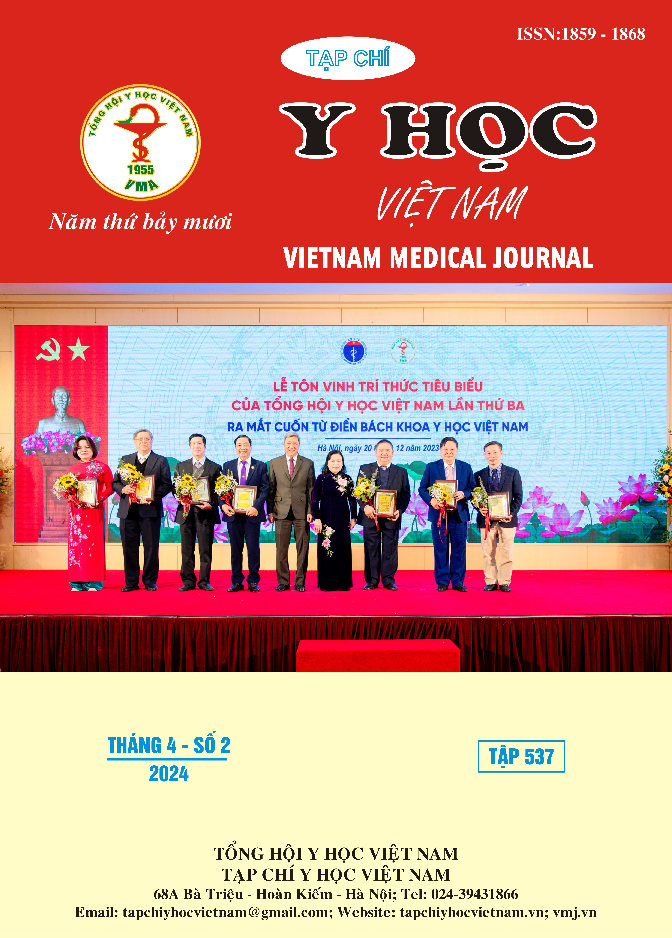VALIDATION OF THE VIETNAMESE VERSION OF HEREK'S ATTITUDE TOWARDS LESBIAN AND GAY SHORT VERSION (ATLG-S)
Main Article Content
Abstract
Herek's attitude toward lesbians and gays scale (ATLG-S) has been widely used to assess the level of acceptance of a segment of the population towards the LGBT (Lesbian, Gay, Bisexual, Transgender). However, this set of questions still does not have a validated Vietnamese version with appropriate methodology. Our research was conducted to validate Herek's scale for students studying at Hanoi Medical University as well as identify factors related to students' attitudes toward lesbians and gays. The research was a cross-sectional descriptive study, convenience sampling was selected, and the sample size was calculated according to Bonnett's formula. The results showed that the item-total correlation coefficient (ITC) of the questions was higher than 0.3. Confirmatory factor analysis (CFA) showed CMIN/df=1.974, GFI = 0.933, CFI = 0.973, TLI = 0.964, RMSEA = 0.070 and PCLOSE=0.086. Therefore, a two-factor structure is accepted. Multivariate logistic regression analysis shows that ethnicity, sex at birth, and friends from the LGBT community are related to attitudes toward lesbians and gays. Our research is essential to supplement data to ensure equitable medical examination and treatment for the LGBT community as well as contribute to promoting equality for sexual minorities in Vietnam.
Article Details
Keywords
lesbian, gay, LGBT
References
2. Ayhan C.H.B., Bilgin H., Uluman O.T., et al. (2020). A Systematic Review of the Discrimination Against Sexual and Gender Minority in Health Care Settings. Int J Health Serv, 50(1), 44–61.
3. Savin-Williams R.C. (1994). Verbal and physical abuse as stressors in the lives of lesbian, gay male, and bisexual youths: Associations with school problems, running away, substance abuse, prostitution, and suicide. Journal of Consulting and Clinical Psychology, 62(2), 261–269.
4. Tri N.M. (2022). Understanding the LGBT subculture in Vietnam: Toward theories of cultural studies. IJEEL, 1(3), 01–07.
5. Kenig N. (2019). Psychometric analysis of the short version of attitudes toward lesbians and gay men scale (ATLG-S). godzbo, 72, 169–182.
6. Herek G.M. (1994). Assessing Heterosexuals’ Attitudes toward Lesbians and Gay Men: A Review of Empirical Research with the ATLG Scale. Lesbian and Gay Psychology: Theory, Research, and Clinical Applications. SAGE Publications, Inc., 2455 Teller Road, Thousand Oaks California 91320 United States, 206–228.
7. Herek G.M. (1988). Heterosexuals’ attitudes toward lesbians and gay men: Correlates and gender differences. Journal of Sex Research, 25(4), 451–477.
8. Dovidio J.F., Johnson J.D., Gaertner S.L., et al. (2010). Empathy and intergroup relations. Prosocial motives, emotions, and behavior: The better angels of our nature. American Psychological Association, Washington, 393–408.
9. Yu Y., Xiao S., and Xiang Y. (2011). Application and Testing the Reliability and Validity of a Modified Version of Herek’s Attitudes Toward Lesbians and Gay Men Scale in China. Journal of Homosexuality, 58(2), 263–274.
10. Nguyen T.Q. and Blum R.W. (2014). Homosexuality Tolerance Among Male and Female Vietnamese Youth: An Examination of Traditional Sexual Values, Self-Esteem, and Demographic/ Contextual Characteristics. Journal of Adolescent Health, 55(6), 823–829.


